Clinical Application of Monitoring Vital Signs in Dogs Through Ballistocardiography (BCG)
Simple Summary
Abstract
1. Introduction
2. Materials and Methods
2.1. Subjects
2.2. Data Collection
2.3. Instrumentation and Measurement Techniques
2.3.1. Ballistocardiography (BCG)
2.3.2. Electrocardiogram (ECG)
2.3.3. Heart Rate (HR) Measurement
2.3.4. Respiratory Rate (RR) Measurement
2.3.5. Anesthetic Procedure and Positioning
2.4. Statistical Analysis
2.4.1. Bland–Altman Plot
2.4.2. Linear Regression Analysis
3. Results
3.1. Awake Beagle Group
3.1.1. Heart Rate
3.1.2. Respiratory Rate
3.2. Anesthetized Dogs’ Group
3.2.1. Heart Rate
3.2.2. Respiratory Rate
4. Discussion
5. Conclusions
Author Contributions
Funding
Institutional Review Board Statement
Informed Consent Statement
Data Availability Statement
Acknowledgments
Conflicts of Interest
References
- Rowan, A.; Kartal, T. Dog population & dog sheltering trends in the United States of America. Animals 2018, 8, 68. [Google Scholar]
- Powell, L.; Stefanovski, D.; Siracusa, C.; Serpell, J. Owner Personality, Owner-Dog Attachment, and Canine Demographics Influence Treatment Outcomes in Canine Behavioral Medicine Cases. Front. Vet Sci. 2021, 7, 630931. [Google Scholar] [CrossRef]
- Pitafi, Z.F.; Song, Y.; Xie, Z.; Brainard, B.; Song, W. Contactless Vital Signs Monitoring for Animals. IEEE Internet Things J. 2025. [Google Scholar] [CrossRef]
- Escobedo, P.; Pousibet-Garrido, A.; López-Ruiz, N.; Carvajal, M.A.; Palma, A.J.; Martínez-Olmos, A. Bed-Based Ballistocardiography System Using Flexible RFID Sensors for Noninvasive Single- and Dual-Subject Vital Signs Monitoring. IEEE Trans. Instrum. Meas. 2024, 73, 1–12. [Google Scholar] [CrossRef]
- Lomaliza, J.P.; Park, H.; Billinghurst, M. Combining Photoplethysmography and Ballistocardiography to Address Voluntary Head Movements in Heart Rate Monitoring. IEEE Access 2020, 8, 226224–226239. [Google Scholar] [CrossRef]
- Pawluk, E.; Delaunois, A.; Gamboa, B.; Valentin, J.P. Comparison of Electrocardiogram and Blood Pressure Recording Methods in Non-Rodent Toxicology Studies: A Retrospective Analysis. J. Pharmacol. Toxicol. Methods 2024, 128, 107537. [Google Scholar] [CrossRef]
- Romito, G.; Castagna, P.; Sabetti, M.C.; Ablondi, M.; Cipone, M. Evaluating the accuracy of a six-lead smartphone-based electrocardiographic device compared with standard electrocardiography in brachymorphic dogs. Vet. Rec. 2023, 193, e2879. [Google Scholar]
- Taniguchi, M.; Kageyama, T.; Okamoto, Y.; Matsunaga, T.; Lee, S.S. A Vital Sign Monitoring System Using a MEMS Microphone for Dog; Institute of Electrical and Electronics Engineers Inc.: New York, NY, USA, 2023; pp. 70–73. [Google Scholar] [CrossRef]
- Chi-Pérez, W.D.; Ríos-Martínez, J.A.; Madera-Ramírez, F.A.; Estrada-López, J.J. Wearable System for Intelligent Monitoring of Assistance and Rescue Dogs. J. Phys. Conf. Series. Inst. Physics 2024, 2699, 012001. [Google Scholar]
- Gordon, J.W. On Certain Molar Movements of the Human Body Produced by the Circulation. J. Anat. 1877, 11, 533–536. [Google Scholar] [PubMed]
- Czapanskiy, M.F.; Ponganis, P.J.; Fahlbusch, J.A.; Schmitt, T.L.; Goldbogen, J.A. An Accelerometer-Derived Ballistocardiogram Method for Detecting Heart Rate in Free-Ranging Marine Mammals. J. Exp. Biol. 2022, 225, jeb243872. [Google Scholar] [CrossRef]
- Suliman, A.; Carlson, C.; Ade, C.J.; Warren, S.; Thompson, D.E. Performance Comparison for Ballistocardiogram Peak Detec-tion Methods. IEEE Access 2019, 7, 53945–53955. [Google Scholar] [CrossRef]
- Kim, C.S.; Ober, S.L.; McMurtry, M.S.; Finegan, B.A.; Inan, O.T.; Mukkamala, R.; Hahn, J.-O. Ballistocardiogram: Mechanism and Poten-tial for Unobtrusive Cardiovascular Health Monitoring. Sci. Rep. 2016, 6, 31297. [Google Scholar]
- López-Ruiz, N.; Escobedo, P.; Ruiz-García, I.; Carvajal, M.A.; Palma, A.J.; Martínez-Olmos, A. Digital Optical Ballistocardiographic System for Activity, Heart Rate, and Breath Rate Determination during Sleep. Sensors 2022, 22, 4112. [Google Scholar] [CrossRef]
- Feng, J.; Huang, W.F.; Jiang, J.; Wang, Y.; Zhang, X.; Li, Q.; Jiao, X. Non-Invasive Monitoring of Cardiac Function through Ballistocardiogram: An Algorithm Integrating Short-Time Fourier Transform and Ensemble Empirical Mode Decomposition. Front. Physiol. 2023, 14, 1201722. [Google Scholar] [CrossRef]
- Alivar, A.; Carlson, C.; Suliman, A.; Warren, S.; Prakash, P.; Thompson, D.; Natarajan, B. Motion Detection in Bed-based Ballistocardiogram to Quantify Sleep Quality. In Proceedings of the GLOBECOM 2017-2017 IEEE Global Communications Conference, Singapore, 4–8 December 2017. [Google Scholar]
- Kahankova, R.; Kolarik, J.; Brablik, J.; Barnova, K.; Simkova, I.; Martinek, R. Alternative Measurement Systems for Recording Cardiac Activity in Animals: A Pilot Study. Anim. Biotelemetry 2022, 10, 15. [Google Scholar] [CrossRef]
- Ballistocardiogram in Veterinary Medicine: Estimating Dog Vital Signs. [CrossRef]
- Silveira, P.S.P.; Vieira, J.E.; Siqueira, J.d.O. Is the Bland-Altman plot method useful without inferences for accuracy, preci-sion, and agreement? Rev. Saude Publica 2024, 58, 1–15. [Google Scholar] [CrossRef]
- Roustaei, N. Application and interpretation of linear-regression analysis. Med. Hypothesis Discov. Innova-Tion Ophthalmol. 2024, 13, 151–159. [Google Scholar] [CrossRef]
- Liu, Z.; Shao, T.; Zhang, X. BCG signal analysis based on improved VMD algorithm. Meas. J. Int. Meas. Confed. 2024, 231, 114631. [Google Scholar] [CrossRef]
- Filzmoser, P.; Nordhausen, K. Robust linear regression for high-dimensional data: An overview. Wiley Interdiscip. Rev. Comput. Stat. 2021, 13, e1524. [Google Scholar] [CrossRef]
- Antink, C.H.; Pirhonen, M.; Vaataja, H.; Somppi, S.; Tornqvist, H.; Cardo, A.; Teichmann, D.; Vainio, O.; Surakka, V.; Vehkaoja, A. Sensor Fusion for Unobtrusive Respiratory Rate Estimation in Dogs. IEEE Sens. J. 2019, 19, 7072–7081. [Google Scholar] [CrossRef]
- Galli, A.; Montree, R.J.H.; Que, S.; Peri, E.; Vullings, R. An Overview of the Sensors for Heart Rate Monitoring Used in Extramural Applications. Sensors 2022, 22, 4035. [Google Scholar] [CrossRef] [PubMed]
- Aich, S.; Chakraborty, S.; Sim, J.S.; Jang, D.J.; Kim, H.C. The design of an automated system for the analysis of the activity and emotional patterns of dogs with wearable sensors using machine learning. Appl. Sci. 2019, 9, 4938. [Google Scholar] [CrossRef]
- Zhang, W.; Xu, M.; Feng, Y.; Mao, Z.; Yan, Z. The Effect of Procrastination on Physical Exercise among College Students—The Chain Effect of Exercise Commitment and Action Control. Int. J. Ment. Health Promot. 2024, 26, 611–622. [Google Scholar]
- Elnaggar, I.; Hurnanen, T.; Sandelin, J.; Lahdenoja, O.; Airola, A.; Kaisti, M.; Koivisto, T. Multichannel Bed-Based Ballistocardiography Heart Rate Estimation Using Continuous Wavelet Transforms and Autocorrelation. In Proceedings of the Computing in Cardiology, Tampere, Finland, 4–7 September 2022. [Google Scholar]
- Liu, S.-H.; Sun, Y.; Wu, B.-Y.; Chen, W.; Zhu, X. Using machine learning models for cuffless blood pressure estimation with ballistocardiogram and impedance plethysmogram. Front. Digit. Health 2025, 7, 1511667. [Google Scholar]
- Kumaki, D.; Motoshima, Y.; Higuchi, F.; Sato, K.; Sekine, T.; Tokito, S. Unobstructive Heartbeat Monitoring of Sleeping Infants and Young Children Using Sheet-Type PVDF Sensors. Sensors 2023, 23, 9252. [Google Scholar] [CrossRef]
- Ezquerro, L.; Coimbra, R.; Bauluz, B.; Núñez-Lahuerta, C.; Román-Berdiel, T.; Moreno-Azanza, M. Large dinosaur egg accumulations and their significance for understanding nesting behaviour. Geosci. Front. 2024, 15, 101872. [Google Scholar]
- Balali, P.; Rabineau, J.; Hossein, A.; Tordeur, C.; Debeir, O.; van de Borne, P. Investigating Cardiorespiratory Interaction Using Ballistocardiography and Seismocardiography—A Narrative Review. Sensors 2022, 22, 9565. [Google Scholar] [CrossRef]
- Zuo, S.; Sigg, S.; Nguyen, L.N.; Beck, N.; Jahne-Raden, N.; Wolf, M.C. CardioID: Secure ECG-BCG Agnostic Interaction-Free Device Pairing. IEEE Access 2022, 10, 128682–128696. [Google Scholar]
- Mohamed, Z. Modeling Cardiovascular, Ocular, and Urinary Systems for Advancing Basic Science, Disease Diagnosis, and Treatment. Ph.D. Thesis, University of Maine, Orono, ME, USA, 2024. [Google Scholar]
- Redondo, J.I.; Rubio, M.; Soler, G.; Serra, I.; Soler, C.; Gómez-Villamandos, R.J. Normal values and incidence of cardiorespiratory complications in dogs during general anaesthesia. A review of 1281 cases. J. Vet. Med. Ser. A Physiol. Pathol. Clin. Med. 2007, 54, 470–477. [Google Scholar]
- Jung, H.; Kimball, J.P.; Receveur, T.; Agdeppa, E.D.; Inan, O.T. Accurate Ballistocardiogram-Based Heart Rate Estimation Using an Array of Load Cells in a Hospital Bed. IEEE J. Biomed. Health Inform. 2021, 25, 3373–3383. [Google Scholar]
- Bouairi, E.; Neff, R.; Evans, C.; Gold, A.; Andresen, M.C.; Mendelowitz, D. Respiratory sinus arrhythmia in freely moving and anesthetized rats. J. Appl. Physiol. 2004, 97, 1431–1436. [Google Scholar] [CrossRef] [PubMed]
- Etemadi, X.M.; Inan, O.T. REVIEW Emerging Wearable Physiological Monitoring Technologies & Decision Aids for Health & Performance. J. Appl. Physiol. 2018, 124, 452–461. [Google Scholar] [PubMed]
- Kimera, S.I.; Mlangwa, J.E.D. Veterinary Ethics. In Encyclopedia of Global Bioethics; Springer International Publishing: Cham, Switzerland, 2015; pp. 1–12. [Google Scholar]
- Ne, C.K.H.; Muzaffar, J.; Amlani, A.; Bance, M. Hearables, in-ear sensing devices for bio-signal acquisition: A narrative review. Expert. Rev. Med. Devices. 2021, 18, 95–128. [Google Scholar] [CrossRef] [PubMed]
- Zhu, F.; Niu, Q.; Li, X.; Zhao, Q.; Su, H.; Shuai, J. FM-FCN: A Neural Network with Filtering Modules for Accurate Vital Signs Extraction. Research 2024, 7, 361. [Google Scholar] [CrossRef]
- Lyu, W.; Yuan, W.; Yu, J.; Wang, Q.; Chen, S.; Qin, J.; Yu, C. Non-Contact Short-Term Heart Rate Variability Analysis Under Paced Respiration Based on a Robust Fiber Optic Sensor System. IEEE Trans. Instrum. Meas. 2024, 73, 1–13. [Google Scholar] [CrossRef]
- Amin, T.; Mobbs, R.J.; Mostafa, N.; Sy, L.W.; Choy, W.J. Wearable devices for patient monitoring in the early postoperative period: A literature review. mHealth 2021, 7, 50. [Google Scholar] [CrossRef]
- Sadek, I.; Biswas, J.; Abdulrazak, B. Ballistocardiogram signal processing: A review. Health Inf. Sci. Syst. 2019, 7, 22. [Google Scholar] [CrossRef]
- Laurino, M.; Menicucci, D.; Gemignani, A.; Carbonaro, N.; Tognetti, A. Moving auto-correlation window approach for heart rate estimation in ballistocardiography extracted by mattress-integrated accelerometers. Sensors 2020, 20, 5438. [Google Scholar] [CrossRef]
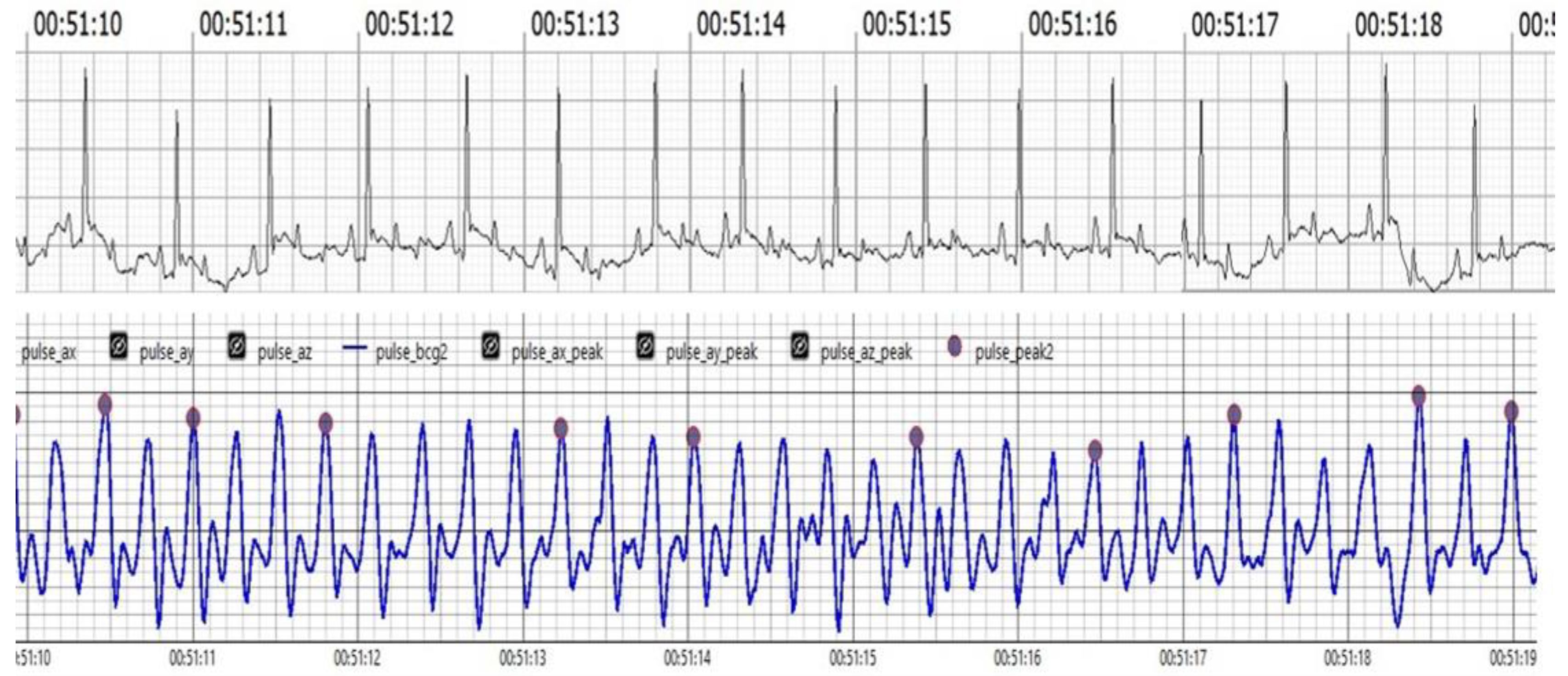
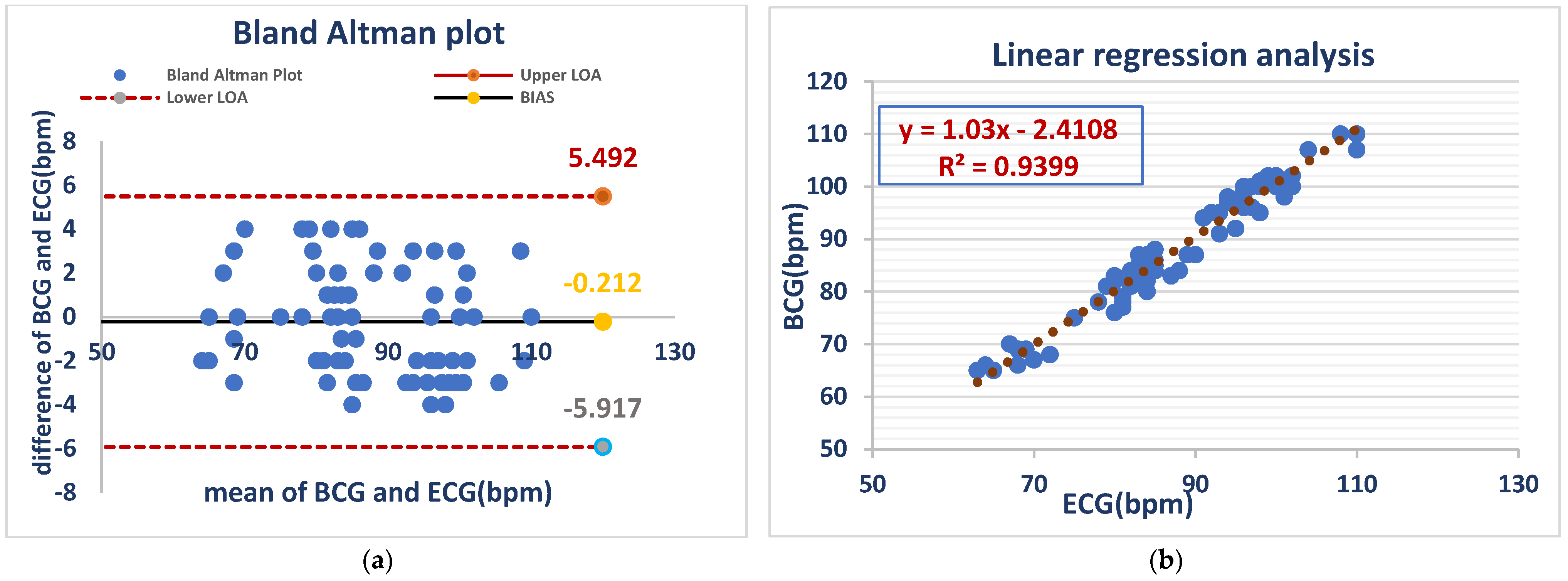
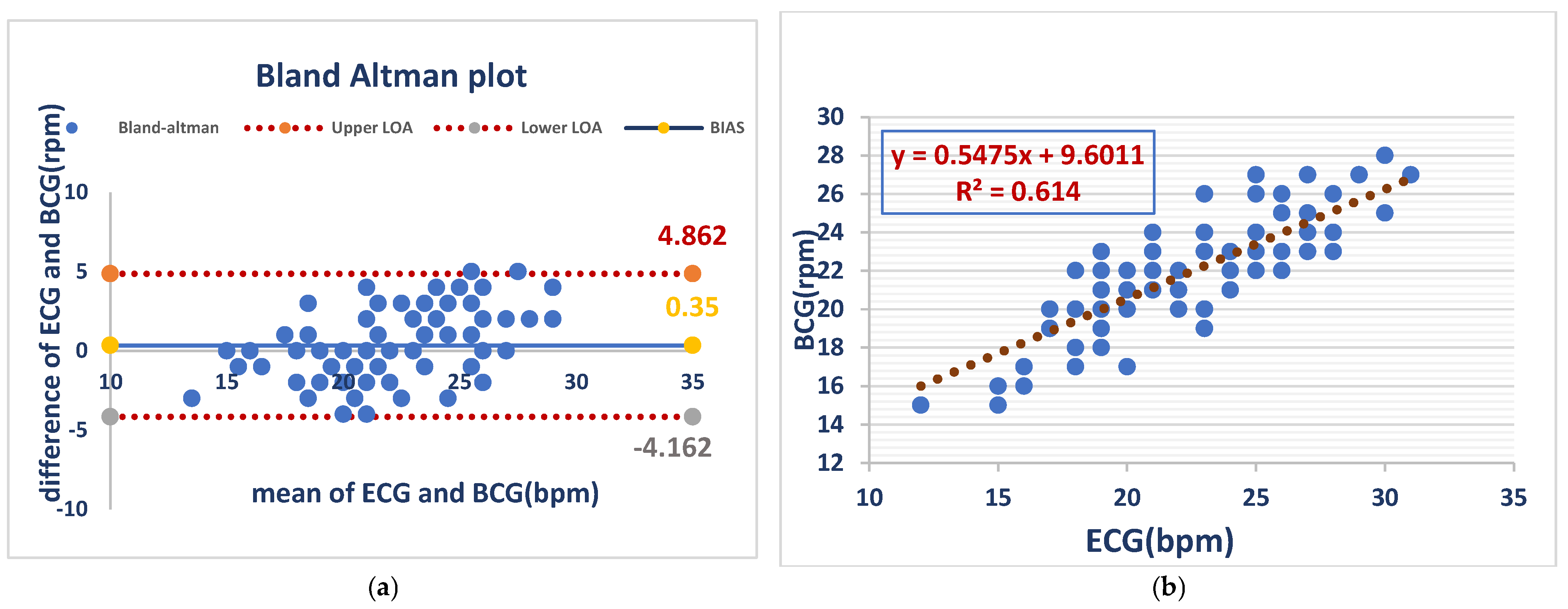

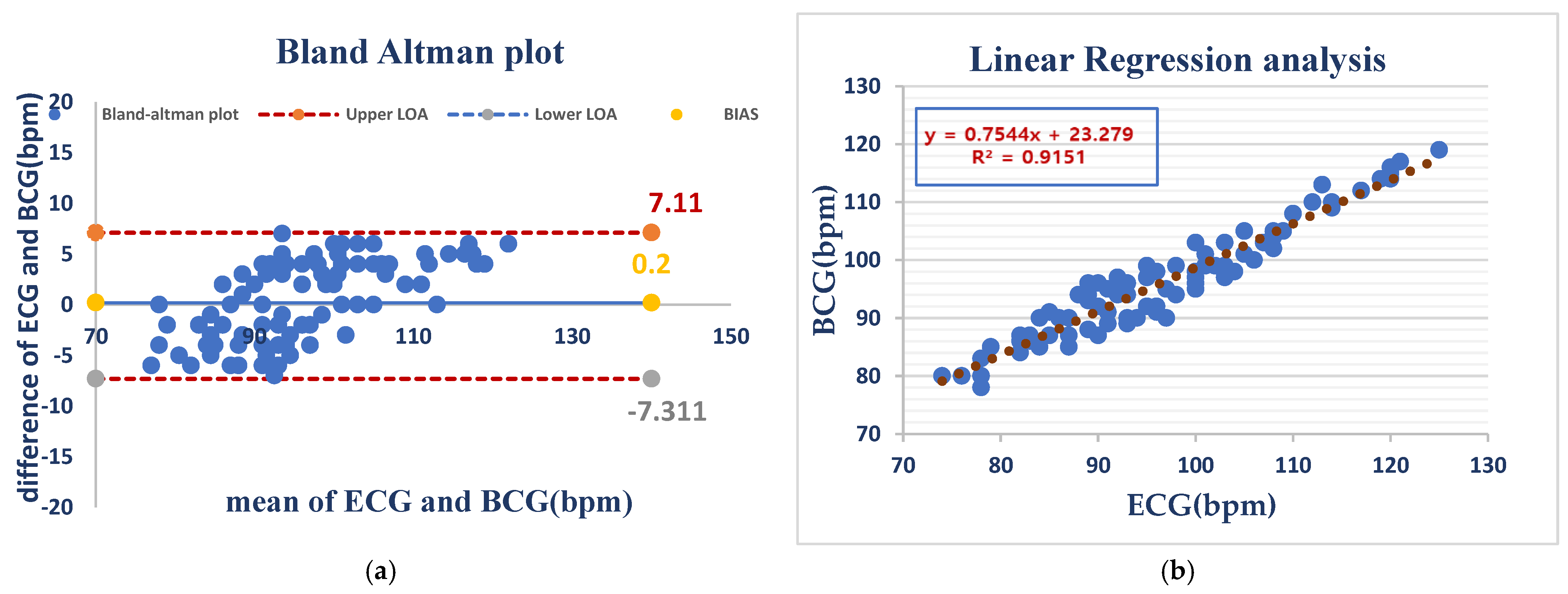
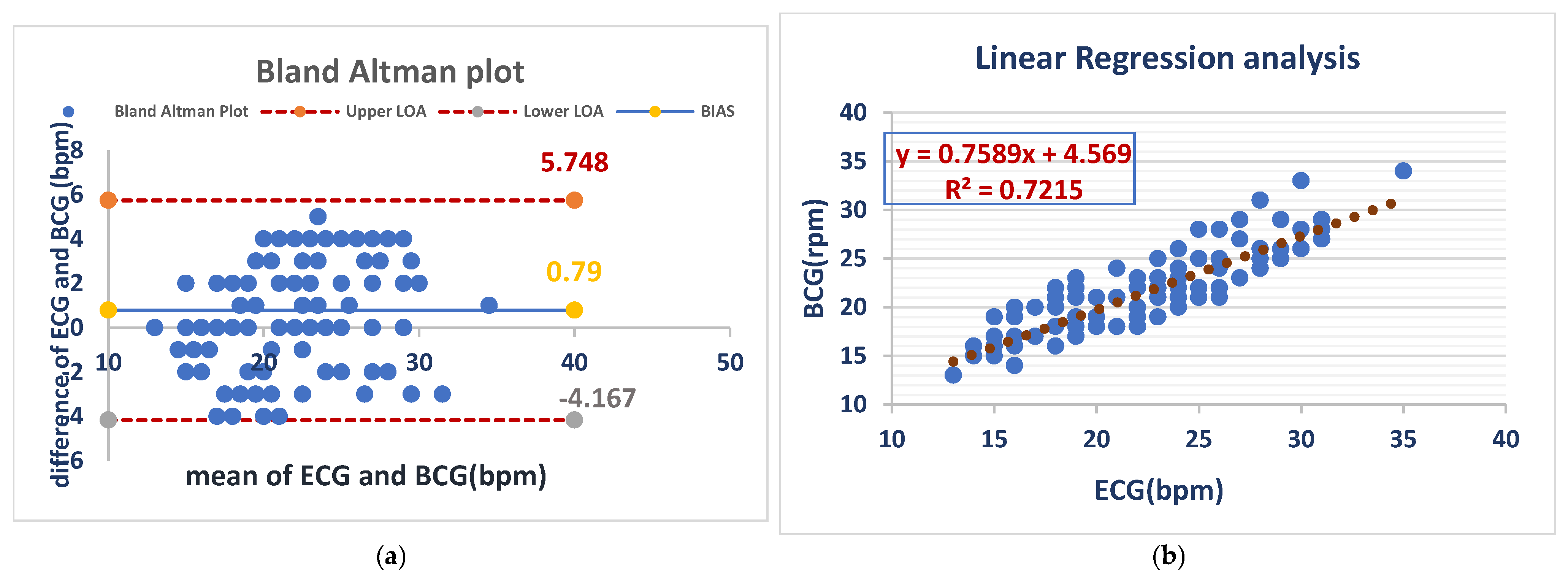
| Number | Breed | Age (Year) | Body Weight (kg) | Gender |
|---|---|---|---|---|
| 1 | Beagle | 3.8 | 14.1 | Male |
| 2 | Beagle | 3.8 | 11.2 | Male |
| 3 | Beagle | 3.8 | 13.4 | Male |
| 4 | Beagle | 3.8 | 11.6 | Female |
| 5 | Beagle | 3.0 | 12.8 | Female |
| 6 | Beagle | 3.0 | 11.5 | Female |
| 7 | Mixed | 1.0 | 22.3 | Male |
| 8 | Mixed | 1.2 | 26.2 | Male |
| 9 | Mixed | 6.5 | 21.7 | Male |
| 10 | Mixed | 7.3 | 31.2 | Male |
| 11 | Mixed | 1.6 | 19.4 | Female |
| 12 | Mixed | 10.2 | 24.3 | Female |
Disclaimer/Publisher’s Note: The statements, opinions and data contained in all publications are solely those of the individual author(s) and contributor(s) and not of MDPI and/or the editor(s). MDPI and/or the editor(s) disclaim responsibility for any injury to people or property resulting from any ideas, methods, instructions or products referred to in the content. |
© 2025 by the authors. Licensee MDPI, Basel, Switzerland. This article is an open access article distributed under the terms and conditions of the Creative Commons Attribution (CC BY) license (https://creativecommons.org/licenses/by/4.0/).
Share and Cite
Chuluunbaatar, B.; Sun, Y.; Chang, K.; Kwak, H.; Chang, J.; Song, W.; Yun, Y. Clinical Application of Monitoring Vital Signs in Dogs Through Ballistocardiography (BCG). Vet. Sci. 2025, 12, 301. https://doi.org/10.3390/vetsci12040301
Chuluunbaatar B, Sun Y, Chang K, Kwak H, Chang J, Song W, Yun Y. Clinical Application of Monitoring Vital Signs in Dogs Through Ballistocardiography (BCG). Veterinary Sciences. 2025; 12(4):301. https://doi.org/10.3390/vetsci12040301
Chicago/Turabian StyleChuluunbaatar, Bolortuya, YungAn Sun, Kyerim Chang, HoYoung Kwak, Jinwook Chang, WooJin Song, and YoungMin Yun. 2025. "Clinical Application of Monitoring Vital Signs in Dogs Through Ballistocardiography (BCG)" Veterinary Sciences 12, no. 4: 301. https://doi.org/10.3390/vetsci12040301
APA StyleChuluunbaatar, B., Sun, Y., Chang, K., Kwak, H., Chang, J., Song, W., & Yun, Y. (2025). Clinical Application of Monitoring Vital Signs in Dogs Through Ballistocardiography (BCG). Veterinary Sciences, 12(4), 301. https://doi.org/10.3390/vetsci12040301






